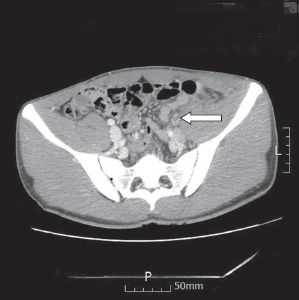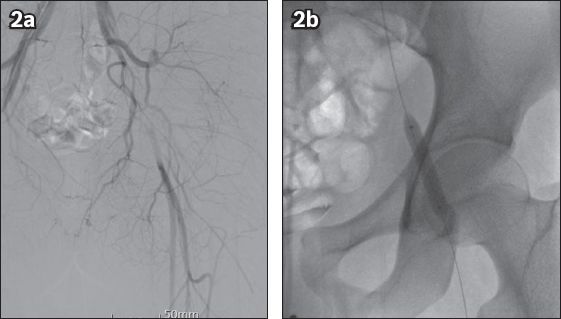Dear Sir,
Blunt vascular trauma is rare relative to penetrating vascular trauma. The incidence of iliac artery injury has been reported to be as low as 0.4% of total arterial trauma.(1) We herein report a rare case of isolated iliac artery injury from blunt trauma without bony injuries.
A 16-year-old male motorcyclist presented with left inguinal pain. His past history was not significant. The patient’s vital signs were: blood pressure 126/76 mmHg; pulse 83 beats/min; respiration 23 breaths/min; body temperature 37°C; and 100% oxygen saturation on room air. He had tenderness in the left inguinal area without bruising or swelling. Motor and sensory examinations of the patient’s extremities were uneventful. Laboratory findings were not significant. On further physical examination, the patient had warm extremities with asymmetric palpable pulses. However, there was no pain or colour changes in the left leg.
Computed tomography (CT) of the abdomen and pelvic area showed haemorrhagic fluid in the left inguinal area. Contrast-enhanced CT revealed poor opacification of the left common and external iliac veins, and femoral vein. There was thrombosis of the left external iliac and a decrease in diameter of the left common femoral artery with perivascular cuffing (
Fig. 1
Abdominal and pelvic CT image shows haemorrhagic fluid in the left inguinal area, poor opacification of the left common and external iliac veins, and a femoral vein with collapsed femoral vein. There is thrombosis of the left external iliac artery (arrow).

The patient underwent percutaneous transluminal angioplasty. Successful arterial recanalisation with two balloon catheters measuring 7 mm × 8 cm and 8 mm × 4 cm was performed for complete arterial occlusion, due to flow-limiting dissection of the left distal external iliac artery leading to the proximal common femoral artery (
Fig. 2
(a) Femoral angiogram shows occlusion of the left distal external iliac artery. (b) Angiogram of percutaneous transluminal angioplasty shows successful arterial recanalisation performed with a balloon catheter for complete arterial occlusion of the left distal external iliac artery leading to the proximal common femoral artery.

Common iliac artery injury from blunt trauma is rare due to the anatomical position of the common iliac artery within the protective pelvic girdle.(2) Iliac artery injuries are often associated with a pelvic fracture or seatbelt injury, and may present with a potentially fatal combination of haemorrhage and limb ischaemia.(3) On presentation, physical examination after blunt trauma may be misleading. Interestingly, many patients may be symptom-free until complete occlusion occurs. CT provides a noninvasive approach to imaging that can characterise the vascular abnormality and thereby guide treatment.(2) In our patient, a patent left femoral artery with an eccentric, displaced dissection flap was visualised on POD 1.
Radiological treatment with thrombolytics or angioplasty regardless of the subsequent stent placement may serve as viable options to improve blood flow and prevent blockage of blood flow to the extremities without vessel surgery.(1) Endovascular techniques have increasingly been utilised in the management of penetrating injuries and even blunt trauma.(4) Careful physical examination is necessary in cases of arterial injury.
Yours sincerely,


